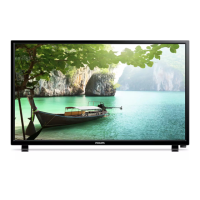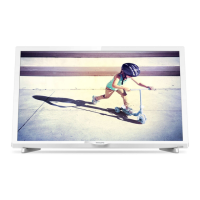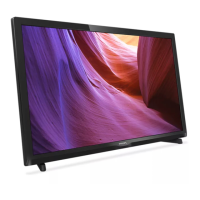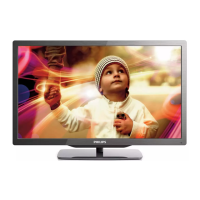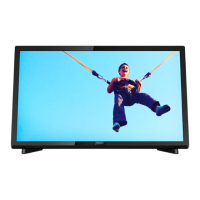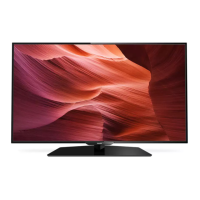Do you have a question about the Philips 24PHS4304 and is the answer not in the manual?
Find TV model and serial numbers for registration and support.
Access on-screen help, software updates, and the user manual.
Contact consumer care for support and repair services.
Install TV software updates via USB or Over-the-Air (OAD).
View the current software version installed on the TV.
Battery replacement, cleaning, and key functions of the remote control.
Use the TV's joystick for basic operations without the remote.
Read safety instructions before using the TV.
Tips for optimal TV placement regarding light and viewing distance.
VESA wall mounting information, including codes and preparation.
Connect the power cable and turn the TV on.
Connect devices for optimal picture and sound transfer.
Connect antenna for DVB-T and DVB-C input signals.
Connect a satellite F-type connector to the TV.
Connect HDMI/DVI devices, HDCP, and EasyLink.
Operate HDMI CEC devices with the TV remote.
Connect audio devices via HDMI ARC and Optical Out.
Connect USB drives for media playback or recording.
Navigate the list of connected input sources.
Watch TV, switch channels, and use the channel list.
Install channels via Antenna/Cable or re-install.
Install and manage satellite channels.
Common issues with satellite installation and reception.
Select and manage subtitle languages and automatic display.
Open and navigate the current channel list.
Rename channels using the on-screen keyboard.
Create and edit lists of favourite TV channels.
Lock channels to prevent viewing without a PIN.
Create and use a list of favourite channels for quick access.
Access and use teletext services for information.
Copy channel list to USB and check its version.
Upload channel list to new or installed TVs.
Open, close, and navigate the TV Guide interface.
Select and switch to programmes directly from the TV Guide.
Set programme reminders for automatic tuning.
Set programmes for recording using the TV Guide.
Requirements for pausing and recording digital TV broadcasts.
Information on recording programmes and necessary setup.
Record the currently viewed programme immediately.
Pause and resume live TV broadcasts.
Connect USB devices to view media files.
View photos from a USB device.
Play video files from a USB device.
Play, pause, and navigate video playback.
Overview of main menu sections: Channels, Sources, Utilities, Settings.
Access frequently used settings and the full settings menu.
Adjust picture style, format, and visual preferences.
Adjust individual picture parameters for optimal viewing.
Select sound styles, adjust bass, treble, and headphone volume.
Configure digital audio output signals for optical and HDMI ARC.
Set up and format a USB Hard Drive for recording.
Reset settings to factory defaults and reinstall the TV.
Set TV menu, audio, and subtitle languages.
Enable features for deaf, hearing impaired, or blind users.
Set and change the child lock code for channels and programmes.
Information on energy efficiency class and consumption.
Instructions for proper disposal of the product and batteries.
Mains power, ambient temperature, and power consumption details.
Technical specifications for receiving TV signals (Aerial, Satellite).
Screen sizes and resolutions for different TV series.
Output power, audio features (Dolby, DTS), and audio connectivity.
Supported USB file systems and playback formats.
List of rear and side TV connections available.
General advice and resources for solving TV problems.
Troubleshooting steps if the TV does not switch on.
Troubleshooting if the TV does not respond to the remote control.
Solutions for picture problems like no picture or poor quality.
Troubleshooting steps for no sound or poor sound quality.
Troubleshooting HDMI connection issues, including HDCP and EasyLink.
Troubleshooting USB device issues, including file display and playback.
Safety instructions to prevent electric shock, injury, or damage.
Precautions against water, heat, and electrical hazards.
Prevent children from climbing or accessing the TV.
Ensure adequate ventilation to prevent overheating.
Instructions for cleaning and caring for the TV screen.
Trademark information for HDMI technology.
Licensing and trademark information for Dolby Audio.
Obtain source code for open source software used in the TV.
README for open source licenses and obtaining copies.
Find TV model and serial numbers for registration and support.
Access on-screen help, software updates, and the user manual.
Contact consumer care for support and repair services.
Install TV software updates via USB or Over-the-Air (OAD).
View the current software version installed on the TV.
Battery replacement, cleaning, and key functions of the remote control.
Use the TV's joystick for basic operations without the remote.
Read safety instructions before using the TV.
Tips for optimal TV placement regarding light and viewing distance.
VESA wall mounting information, including codes and preparation.
Connect the power cable and turn the TV on.
Connect devices for optimal picture and sound transfer.
Connect antenna for DVB-T and DVB-C input signals.
Connect a satellite F-type connector to the TV.
Connect HDMI/DVI devices, HDCP, and EasyLink.
Operate HDMI CEC devices with the TV remote.
Connect audio devices via HDMI ARC and Optical Out.
Connect USB drives for media playback or recording.
Navigate the list of connected input sources.
Watch TV, switch channels, and use the channel list.
Install channels via Antenna/Cable or re-install.
Install and manage satellite channels.
Common issues with satellite installation and reception.
Select and manage subtitle languages and automatic display.
Open and navigate the current channel list.
Rename channels using the on-screen keyboard.
Create and edit lists of favourite TV channels.
Lock channels to prevent viewing without a PIN.
Create and use a list of favourite channels for quick access.
Access and use teletext services for information.
Copy channel list to USB and check its version.
Upload channel list to new or installed TVs.
Open, close, and navigate the TV Guide interface.
Select and switch to programmes directly from the TV Guide.
Set programme reminders for automatic tuning.
Set programmes for recording using the TV Guide.
Requirements for pausing and recording digital TV broadcasts.
Information on recording programmes and necessary setup.
Record the currently viewed programme immediately.
Pause and resume live TV broadcasts.
Connect USB devices to view media files.
View photos from a USB device.
Play video files from a USB device.
Play, pause, and navigate video playback.
Overview of main menu sections: Channels, Sources, Utilities, Settings.
Access frequently used settings and the full settings menu.
Adjust picture style, format, and visual preferences.
Adjust individual picture parameters for optimal viewing.
Select sound styles, adjust bass, treble, and headphone volume.
Configure digital audio output signals for optical and HDMI ARC.
Set up and format a USB Hard Drive for recording.
Reset settings to factory defaults and reinstall the TV.
Set TV menu, audio, and subtitle languages.
Enable features for deaf, hearing impaired, or blind users.
Set and change the child lock code for channels and programmes.
Information on energy efficiency class and consumption.
Instructions for proper disposal of the product and batteries.
Mains power, ambient temperature, and power consumption details.
Technical specifications for receiving TV signals (Aerial, Satellite).
Screen sizes and resolutions for different TV series.
Output power, audio features (Dolby, DTS), and audio connectivity.
Supported USB file systems and playback formats.
List of rear and side TV connections available.
General advice and resources for solving TV problems.
Troubleshooting steps if the TV does not switch on.
Troubleshooting if the TV does not respond to the remote control.
Solutions for picture problems like no picture or poor quality.
Troubleshooting steps for no sound or poor sound quality.
Troubleshooting HDMI connection issues, including HDCP and EasyLink.
Troubleshooting USB device issues, including file display and playback.
Safety instructions to prevent electric shock, injury, or damage.
Precautions against water, heat, and electrical hazards.
Prevent children from climbing or accessing the TV.
Ensure adequate ventilation to prevent overheating.
Instructions for cleaning and caring for the TV screen.
Trademark information for HDMI technology.
Licensing and trademark information for Dolby Audio.
Obtain source code for open source software used in the TV.
README for open source licenses and obtaining copies.
| Screen Size | 24 inches |
|---|---|
| Display Type | LED |
| HDMI Ports | 2 |
| USB Ports | 1 |
| Smart TV | No |
| HD type | HD |
| Screen shape | Flat |
| Aspect ratio | 16:9 |
| VESA mounting | Yes |
| VESA mounting interfaces | 100 x 100 mm |
| Weight | 3.1 kg |
| Refresh Rate | 60 Hz |
| Built-in Wi-Fi | No |
| Resolution | 1366 x 768 |
| Display diagonal | 24 inches |
| Digital signal format system | DVB-T2/C |
